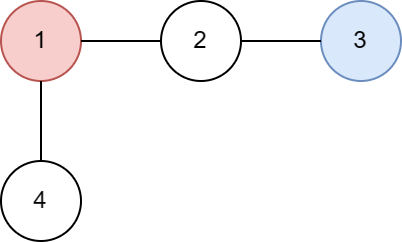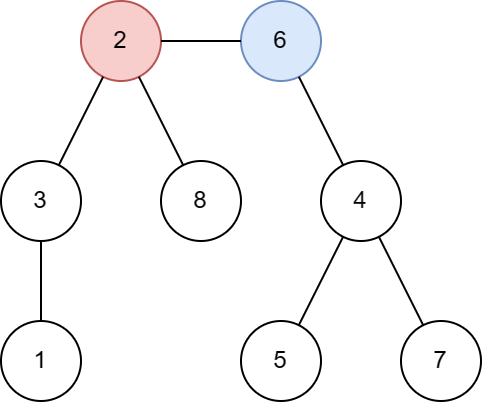310374: CF1823F. Random Walk
Description
You are given a tree consisting of $n$ vertices and $n - 1$ edges, and each vertex $v$ has a counter $c(v)$ assigned to it.
Initially, there is a chip placed at vertex $s$ and all counters, except $c(s)$, are set to $0$; $c(s)$ is set to $1$.
Your goal is to place the chip at vertex $t$. You can achieve it by a series of moves. Suppose right now the chip is placed at the vertex $v$. In one move, you do the following:
- choose one of neighbors $to$ of vertex $v$ uniformly at random ($to$ is neighbor of $v$ if and only if there is an edge $\{v, to\}$ in the tree);
- move the chip to vertex $to$ and increase $c(to)$ by $1$;
You'll repeat the move above until you reach the vertex $t$.
For each vertex $v$ calculate the expected value of $c(v)$ modulo $998\,244\,353$.
InputThe first line contains three integers $n$, $s$ and $t$ ($2 \le n \le 2 \cdot 10^5$; $1 \le s, t \le n$; $s \neq t$) — number of vertices in the tree and the starting and finishing vertices.
Next $n - 1$ lines contain edges of the tree: one edge per line. The $i$-th line contains two integers $u_i$ and $v_i$ ($1 \le u_i, v_i \le n$; $u_i \neq v_i$), denoting the edge between the nodes $u_i$ and $v_i$.
It's guaranteed that the given edges form a tree.
OutputPrint $n$ numbers: expected values of $c(v)$ modulo $998\,244\,353$ for each $v$ from $1$ to $n$.
Formally, let $M = 998\,244\,353$. It can be shown that the answer can be expressed as an irreducible fraction $\frac{p}{q}$, where $p$ and $q$ are integers and $q \not \equiv 0 \pmod{M}$. Output the integer equal to $p \cdot q^{-1} \bmod M$. In other words, output such an integer $x$ that $0 \le x < M$ and $x \cdot q \equiv p \pmod{M}$.
ExamplesInput3 1 3 1 2 2 3Output
2 2 1Input
4 1 3 1 2 2 3 1 4Output
4 2 1 2Input
8 2 6 6 4 6 2 5 4 3 1 2 3 7 4 8 2Output
1 3 2 0 0 1 0 1Note
The tree from the first example is shown below:

- $P(c(1) = 0) = 0$, since $c(1)$ is set to $1$ from the start.
- $P(c(1) = 1) = \frac{1}{2}$, since there is the only one series of moves that leads $c(1) = 1$. It's $1 \rightarrow 2 \rightarrow 3$ with probability $1 \cdot \frac{1}{2}$.
- $P(c(1) = 2) = \frac{1}{4}$: the only path is $1 \rightarrow_{1} 2 \rightarrow_{0.5} 1 \rightarrow_{1} 2 \rightarrow_{0.5} 3$.
- $P(c(1) = 3) = \frac{1}{8}$: the only path is $1 \rightarrow_{1} 2 \rightarrow_{0.5} 1 \rightarrow_{1} 2 \rightarrow_{0.5} 1 \rightarrow_{1} 2 \rightarrow_{0.5} 3$.
- $P(c(1) = i) = \frac{1}{2^i}$ in general case.


Input
题意翻译
树上从 $s$ 走到 $t$,随机游走,求走到每个点的期望次数。$2\le n\le 2\times 10^5$。 翻译 @zlxFTH。Output
给定一个包含n个顶点和n-1条边的树,每个顶点v都有一个计数器c(v)与之关联。初始时,一个筹码放在顶点s上,除了c(s)之外的所有计数器都设置为0;c(s)设置为1。目标是使筹码到达顶点t。可以通过一系列移动来实现。假设现在筹码放在顶点v上。在一次移动中,执行以下操作:
1. 随机均匀地选择顶点v的一个邻居to(to是v的邻居,当且仅当树中存在边{v, to});
2. 将筹码移动到顶点to并增加c(to)的值1;
重复上述移动,直到达到顶点t。
对于每个顶点v,计算c(v)的期望值模998,244,353。
输入输出数据格式:
输入:
第一行包含三个整数n、s和t(2≤n≤2×10^5;1≤s,t≤n;s≠t)——树中顶点的数量和起始及结束顶点。
接下来n-1行包含树的边:每行一个边。第i行包含两个整数u_i和v_i(1≤u_i,v_i≤n;u_i≠v_i),表示节点u_i和v_i之间的边。
保证给定的边构成一棵树。
输出:
打印n个数字:每个顶点v的c(v)的期望值模998,244,353,对于v从1到n。
形式上,设M=998,244,353。可以看出答案可以表示为不可约分数p/q,其中p和q是整数,且q≢0(mod M)。输出整数等于p⋅q^(-1)mod M。换句话说,输出一个整数x,使得0≤x